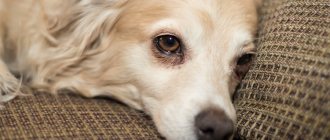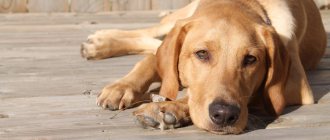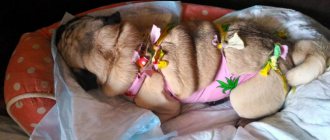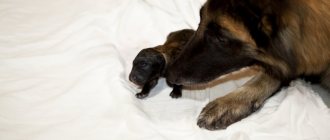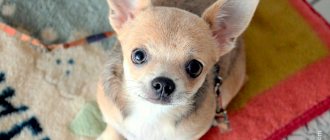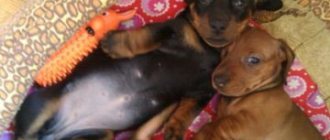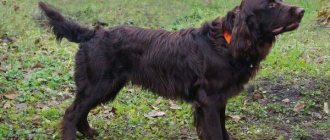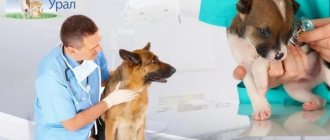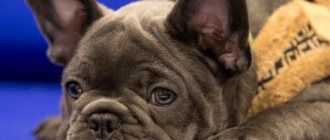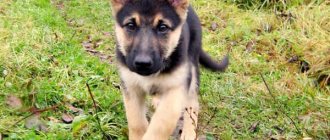Photo: Dog after surgery
Unfortunately, our four-legged friends sometimes get sick and are forced to undergo operations of varying complexity. To completely cure your beloved pet, it is not enough to entrust it to a competent veterinarian. After qualified medical intervention, the owner must independently care for the sick animal properly. We will tell you what a stitch means in a dog after surgery, and how to properly care for it during the rehabilitation period.
How long does it take for a dog to recover after sterilization?
Conventionally, the period after surgery can be divided into 3 parts:
- recovery after anesthesia (12-24 hours);
- healing period of sutures (on average 10-14 days);
- complete recovery of the dog (up to a month).
The timing of each period depends on the characteristics of the dog’s body, its immunity and, most importantly, on the type of operation. After laparoscopic sterilization, the stitches are minimal, require virtually no treatment, and the dog’s recovery is faster. The specific timing of each period should be checked with your doctor.
Types of anesthesia for dogs and drugs
Inhalation
With this method of pain relief, drugs enter the pet’s body through a special mask or tube directly into the respiratory system. Next, we will consider the pros, cons and possible consequences of gas anesthesia for dogs.
Pros:
- instantly putting the patient to sleep;
- after stopping the drug administration, the pet quickly wakes up.
Minuses:
- the most expensive method of anesthesia, as it requires special equipment and personnel training;
- has virtually no analgesic effect.
Preparations:
- isoflurane;
- sevoflurane.
Intravenous
Currently, intravenous anesthesia is the most common type of anesthesia in the treatment of pets. The method involves administering drugs through a vein and putting the animal into deep sleep.
Pros:
- a fairly economical method; drugs for intravenous anesthesia are available in any veterinary clinic;
- suitable for both quick and long-term operations, since the dose of drugs is easy to regulate;
- allows for maximum pain relief for your pet.
Minuses:
- possible decrease in body temperature;
- possible decrease in pressure;
- convulsions may occur upon awakening.
Preparations:
- acepromazine;
- opioids;
- diazepam;
- propofol;
- gilded;
- medetomidine;
- ketamine.
Local anesthesia
Local anesthesia includes a wide range of different types of anesthesia - from the simplest application (an anesthetic drug is applied to the skin without an injection) to epidural anesthesia, which is used as an additional method of pain relief during surgery on the hind limbs, sterilization, etc. The principle of this type of anesthesia consists in blocking the conduction of nerve impulses coming from a specific nerve.
Pros:
- allows you to significantly reduce the dose of intravenous anesthesia or not use it at all (for simple operations);
- allows operations to be performed on patients for whom intravenous anesthesia is contraindicated.
Minuses:
- damage to the nerve and surrounding tissues is possible if pain relief is performed incorrectly;
- possible bleeding and hematoma formation at the injection site;
- risk of infection entering the spinal canal;
- the risk of developing urinary disorders after epidural anesthesia.
Preparations:
- Lidocaine;
- Bupivacaine;
- Ropivacaine.
Observation and care during the first days
Your dog has been sterilized; what immediate care will she need after surgery? It is preferable to spend the first day after surgery in the clinic. There is an opportunity to quickly help the animal in case of unexpected complications. With correctly calculated anesthesia, the dog will begin to come to its senses almost immediately after the operation or within a couple of hours, but it will take a day for it to fully recover.
Keep in mind that the animal will be slightly out of control and may be timid or aggressive. Talk to your pet in a calm, gentle voice, provide peace, but do not leave her alone to monitor her condition.
A four-legged patient must be wearing a special blanket to protect the stitches. Then she is laid on a flat, low bedding covered with moisture-absorbing diapers. The sofa will not work - the dog does not control its paws and may fall off it. When your pet comes out of anesthesia, it is cold; be sure to cover it with a light blanket or rug, and place the bedding not in drafts. Additional heaters are not required to avoid causing bleeding.
The animal cannot control urination in this state, so a diaper is required. Once every half hour it must be changed, and the dog must be turned from side to side to prevent swelling. During hot weather, your veterinarian may recommend using a syringe without a needle to pour some water into your dog's mouth. But usually it is enough to wet the nose and mouth. You should not offer food on the first day, as the dog may choke.
In what cases is anesthesia given?
It’s probably no secret that anesthesia is necessary for complex operations. Thanks to the intensive development of veterinary medicine, it is now possible to help seemingly the most hopeless pets: surgeons perform heart operations, remove tumors in the brain, and replace the lens of the eye.
But the need for anesthesia is observed much more often than owners might imagine. Without complete immobilization and anesthesia of the patient, it is no longer possible to imagine carrying out a variety of procedures:
- planned operations (sterilization, teeth cleaning);
- emergency operations (for medical reasons, for example, osteosynthesis);
- diagnostic procedures (for example, MRI and CT are performed only under anesthesia);
- treatment of extensive wounds, installation of drainages, etc.
Anesthesia can also be used when examining and transporting aggressive animals.
Contraindications
At the moment, anesthesia can be given to a patient in almost any condition, provided there are emergency indications for surgery. But, of course, there are contraindications for cosmetic and other non-urgent operations. That is, when the possible risks of anesthesia exceed the benefits of the operation.
The main contraindications include:
- kidney diseases;
- heart disease;
- pregnancy and feeding of puppies;
- dehydration;
- viral or bacterial infections in the acute stage.
It is worth noting that age is not a contraindication to administering anesthesia. In modern conditions, the operation can be performed safely on both a two-week-old puppy and a twenty-year-old dog.
Seam processing
After sterilization, the dog’s suture itches, hurts and causes anxiety. The pet will try to get to the injured area and lick the wound. It is strictly forbidden to allow this to happen - the dog will tear out the threads and the wound will open.
To protect the operated area, a special blanket is put on the dog. A bandage that is too tight is not needed; the blanket should allow air to pass through. It must be changed to a clean one once a day so as not to introduce infection into the wound. One blanket is often not enough - an active pet left unattended will easily tear it. In this case, a special collar is needed. It will prevent the dog from licking its belly.
Twice a day, the seam must be inspected and treated with an antiseptic. The veterinarian will tell the owner in more detail how many days to do this and what drug to use. He will also prescribe antibiotics and painkillers if necessary. Filling the seam with iodine, brilliant green, and alcohol is strictly prohibited. Only the skin around the seam is treated. In this case, movements should be careful, without pressing or rubbing. The resulting crusts must be soaked and carefully removed.
How long the suture takes to heal after sterilization in a dog depends on its individual characteristics. This usually takes 10-14 days. If simple surgical sutures were used, they should be removed by a veterinarian. Self-absorbable suture material will not require removal, but you still need to show the dog to a doctor so that a specialist can assess its condition.
Care of surgical sutures
It is very important to systematically monitor the condition of surgical sutures until they are removed in order to avoid inflammation, suppuration, and other possible complications.
Advice! The veterinary surgeon who performed the sterilization will tell you how to properly care for and how to treat the sutures.
When you arrive home, put a blanket made of sterile “breathable” material on your dog. If the pet chews and licks the seams, an inflammatory process will begin due to the penetration of pathogenic flora and bacteria into the wounds. You can also put a protective collar on your dog.
Advice! In the first 2-3 days, the seam may bleed, so prepare 2-3 blankets for changing. Normally, a small amount of light pink liquid may leak from a postoperative wound.
It is prohibited to bathe the dog, wet the sutures, use aggressive alcohol solutions for treatment, or let the dog off the leash on the street until the postoperative sutures are removed.
To treat the seam, antiseptic agents are prescribed in the form of solutions. Treatment is carried out with sterile gauze discs. You can also use a bandage folded in several layers. We do not recommend using cotton pads to treat seams due to the fact that cotton fibers can cause inflammation.
Gauze discs are generously moistened with hydrogen peroxide and another antiseptic. The seam is carefully processed along its entire length, periodically changing napkins. Dry crusts and blood clots are also removed with a swab soaked in antiseptic.
After the initial hygiene of the sutures, wound-healing, anti-inflammatory, and analgesic drugs are used in the form of ointments, gels, liniments, and aerosols. Before applying external preparations, the seam is wiped dry.
Dog food
You can offer food to your pet only after she has fully recovered and all her functions have been restored. Before this, you should not feed the dog - it may choke because it does not fully control its muscles. The first feeding should be soft - pate, puree or wet food. For the first three days after surgery, it is recommended to moisten dry food, if it is in the diet, with water.
Then they switch to a normal diet, but taking into account the fact that the dog’s feeding after sterilization changes in the direction of reducing calorie content. The fact is that sterilized animals are prone to weight gain; special diets have been developed for them.
More about the operation
Nephrectomy is a surgical intervention that is used if the functionality or anatomical structure of an organ is so impaired that it is not possible to restore it. When deciding to remove an organ, the surgeon is guided by many factors - the general condition of the patient, the presence of problems with the functionality of the other kidney, the possibility of the pathological process spreading to nearby organs and systems.
The operation is performed open or laparoscopically:
- Laparoscopic nephrectomy is a low-traumatic operation that is performed through several mini-punctures in the abdominal wall. The surgeon inserts laparoscopic instruments through these punctures and, under the control of a video camera, performs all the necessary manipulations;
- open nephrectomy - performed through a large incision in the abdominal cavity. Such an intervention is resorted to if the kidney is affected by a large tumor, which is difficult or impossible to remove laparoscopically. The surgeon excises not only the organ, but also the surrounding fatty tissue, lymph nodes and fascia.
Physical activity and walks
After surgery, physical activity is not allowed. You can go outside approximately 10 days after sterilization, depending on the dog’s condition. The walk should be short, at a calm pace, without unnecessary activity. The owner’s task is to protect the dog from encounters with aggressive animals, jerks and other surprises. Otherwise the seams may come apart. It is also important to prevent dirt and snow from getting into the wound area, and do not walk on tall grass.
On average, after a month the dog can return to normal life. But it is better to check this period with your veterinarian.
Why do you need to process a seam?
In principle, provided that a bandage is applied, as well as the use of a surgical collar that prevents the dog from reaching the postoperative wound, there is no particular need for bandaging. If sterilization was performed laparoscopically, then in most cases the sutures are not processed at all.
But still, situations are different. Thus, when old dogs are deprived of food, in most cases, specialists resort to classical abdominal surgery. In this case, achieving a small and neat cut can be either difficult or completely impossible. Therefore, in such situations, the seam is processed. This is done to speed up the healing process, as well as to relieve the pet from unpleasant sensations.
Danger signs: when to go to the vet
As a rule, veterinarians themselves draw the attention of owners to signs that the dog needs urgent help. Many even issue a special reminder. You should be wary:
- long sleep after anesthesia;
- high or low temperature in the dog;
- difficulty or uneven breathing, fainting;
- pale to blue mucous membranes;
- separation, redness, suppuration of the suture, increase in its temperature;
- the appearance of cones (hernias) at the suture site.
In these cases, you must urgently contact your doctor and be ready to go to the clinic.
Operations for dogs at the Biryulevsky Veterinary Center
Our clinic performs a wide variety of operations on animals. We have a qualified team of doctors, we carry out diagnostics, laboratory tests and preparation for operations using high-quality, high-precision equipment. At your request, we are ready to treat postoperative sutures on your dog. You can make an appointment with a veterinarian by calling the numbers listed on the main page or using the online appointment form.
APPOINTMENT WITH A VETERINARIAN
You can view the list of operations performed by doctors at the Biryulevsky Veterinary Center at the link
How often should you visit the vet after surgery?
The dog does not need extra visits to the clinic during the postoperative period. During the trip, there is a chance that the wound will be disturbed, and in the clinic itself you will encounter an infection. If the veterinarian has not recommended anything else and healing is proceeding without problems, you can only get by with a visit to remove the stitches after 14 days. Your veterinarian may also suggest tests and an ultrasound to make sure healing is successful.
In rare cases, the bitch remains in heat after surgery. This means that the ovary was not completely removed. An additional visit to the doctor will be required to examine and correct the situation.
How to prepare your pet for anesthesia
Proper preparation for anesthesia is the key to the success of the upcoming procedure. It includes not only a starvation diet, but also a set of preoperative examinations.
If your pet is undergoing a planned operation (for example, sterilization) and has not previously been ill, blood tests (general and biochemistry) and heart examinations may be sufficient. If your pet has any concomitant pathology, it is imperative to conduct a full preoperative examination and consult a specialist.
Also, to reduce the risk of possible complications, before carrying out planned operations, it is recommended to treat your pet for worms (7-10 days in advance) and make sure that he is vaccinated on time.
When is it time to remove stitches and how does it happen?
The sutures are removed when the wound has healed completely. First, the animal is restrained, since the procedure, although not painful, is unpleasant. Then the doctor treats the skin in the suture area with an antiseptic, cuts the thread with scissors and removes it with tweezers. A cosmetic suture made from absorbable threads does not require removal.
As you can see, caring for your dog after surgery is necessary, but there is nothing terrible about it. A loving owner will need time, patience and strict adherence to the veterinarian’s instructions, then healing will be painless for everyone.
Possible consequences and complications
With careful preparation for the procedure, the operation being performed by competent specialists and the dog recovering from anesthesia under the supervision of doctors, there should be no consequences from its use. Direct administration of drugs for anesthesia does not harm the health of the pet. But, if the pet had any systemic diseases and pathologies before the operation, they may worsen (for example, kidney and heart diseases). To avoid this, a thorough examination is required not only before the operation, but also after it, in order to notice the appearance of complications in time!
List of contraindications to the use of anesthesia
It is not always possible to administer anesthesia to an animal; most often this occurs in the presence of the following contraindications:
- period of estrus, pregnancy, lactation;
- for acute viral diseases and chronic diseases of the genitourinary organs;
- problems with the heart and blood vessels, respiratory organs;
- if the dog is over 10 years old
If, despite the above symptoms, the operation is decided to be carried out, the doctor is obliged to warn the owner about possible adverse consequences and obtain written consent to carry out all surgical measures.
What symptoms are not cause for concern?
After anesthesia, the dog may feel sick and vomit. The cramps help keep her warm, and a little emptying of her stomach will help her feel better.
Attacks of aggression and fear sometimes persist until the dog regains control over his body. At first, it may sway: animals fall to the side, twitch their paws, whine or do not get up.
If your dog loses his appetite, do not force him to eat. A short hunger strike will even be useful.
How is nephrectomy performed?
Kidney removal is performed by two main methods - open and laparoscopic.
With open nephrectomy, access to the organ is provided through a cavity incision sufficient to visualize the surgical procedures being performed. Laparoscopic nephrectomy is performed through several micropunctures of the abdominal wall, into which the surgeon inserts instruments and an endovideo camera. Using instruments, the surgeon mobilizes nearby organs (intestines, pancreas) to prevent their displacement or damage. Then he carefully identifies the vessels feeding the organ, pinches, cuts off and clips/ligates them. The ureter is clamped and the kidney is excised. If the intervention is performed for a malignant tumor, the kidney is removed along with the fatty tissue and fascial membrane. If the pathological process is widespread, the lymph nodes and adrenal gland are also removed (to prevent metastasis).
After coagulating the vessels and suturing the internal tissues, the surgeon installs a drainage tube and sutures the surgical wound layer by layer. The patient is given a sterile bandage and transported to the hospital room.
What is not normal? There are several reasons to worry about your animal:
- Continuous shaking and convulsions;
- The heart beats too fast or too slow;
- Uneven, rapid breathing, wheezing.
The doctor should explain what is normal, but if you are concerned about the animal’s condition, you should immediately contact a veterinarian.
Having woken up from anesthesia, the dog will try to get to its feet, stagger, try to walk, and often the pet may vomit, all this is normal, but this part of the rehabilitation requires special attention. The pet is disoriented and at this time may become injured, not respond to the owner or react inappropriately, get scared, or become aggressive. It is worth showing understanding and trying to surround the dog with calm, give it some more rest, carefully monitor and secure the environment around it so that the pet does not get stuck anywhere or fall from a height. You cannot feed or water the dog at this time; you can give it water when it is stable on its feet and moving around.
Warning symptoms
Usually any ailments go away within 24 hours. If symptoms persist for a longer period of time, take your pet to the clinic. Among the warning signs are:
- bleeding;
- opening of a suture or the appearance of pus in the wound;
- cyanosis of mucous membranes;
- high fever, nausea;
- frequent shallow breathing;
- shortness of breath, cough, wheezing.
An alarming symptom if swelling appears at the wound site. Respiratory disorders and inflammatory processes often lead to the death of the animal.
Indications for surgery
The absolute indications for nephrectomy are the following pathological conditions:
- severe traumatic injuries accompanied by kidney rupture;
- large tumors that have destroyed the structure of the organ;
- abnormalities in the structure of the kidney that contribute to the development of serious complications;
- terminal hydronephrosis;
- kidney stones with purulent organ damage (pyonephrosis);
- wrinkled bud.
Surgical tactics are selected by a specialist in accordance with the diagnosis, severity of the disease, general condition, etc. The surgeon makes the decision regarding surgical intervention after a comprehensive diagnostic examination.
